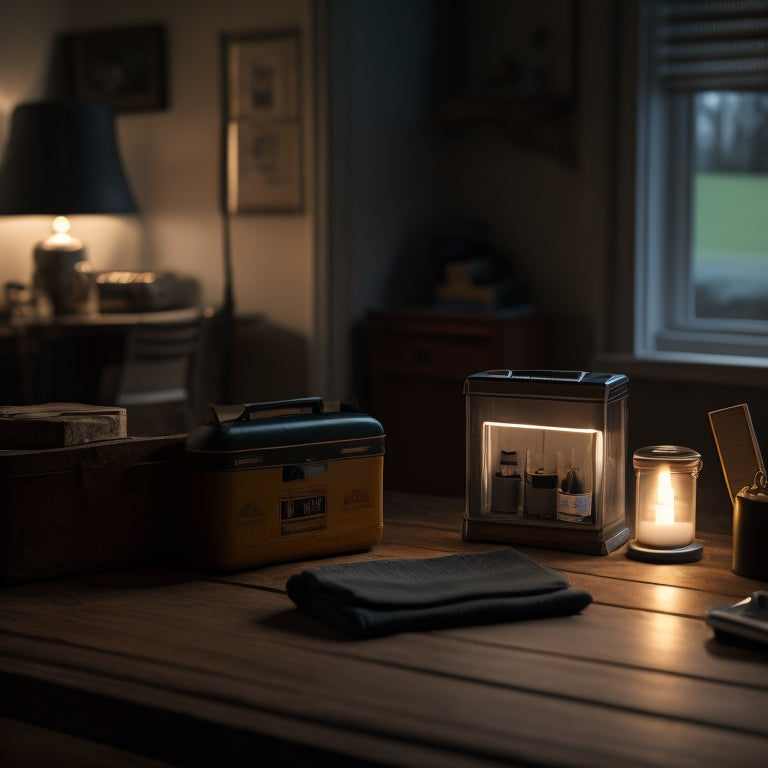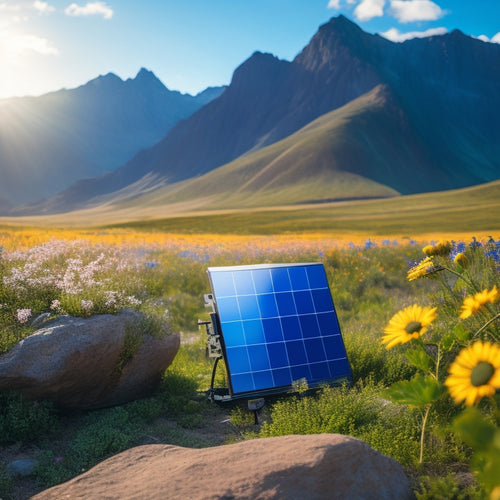
Emergency Energy Kit for Homeowners
Share
You're looking to create an emergency energy kit for your home, ensuring a reliable power supply during outages. This kit typically consists of three components: a power source, energy storage system, and power distribution mechanism. Evaluating factors like cycle life expectancy, maintenance, and generator options is vital. You'll also need to take into account solar panel types, mounting solutions, and DIY installation considerations, including safety precautions and system compatibility. As you investigate these essential elements, you'll uncover the secrets to creating an all-encompassing kit that keeps your critical appliances running, giving you peace of mind and energy independence during emergency situations.
Overview
- A reliable emergency energy kit requires three essential components: power source, energy storage system, and power distribution mechanism.
- Solar panel kits can provide a sustainable power source, with options including monocrystalline, polycrystalline, and thin-film panels.
- Battery backup systems are critical for keeping essential appliances operational during grid failures, with options including lead-acid, lithium-ion, and nickel-cadmium batteries.
- DIY installation requires careful consideration of system compatibility, safety precautions, and electrical connections to ensure seamless integration with existing systems.
- Regular inspection, maintenance, and testing are necessary to ensure the kit's functionality and reliability during power outages.
Emergency Power Essentials
Three critical components form the foundation of emergency power essentials: a power source, an energy storage system, and a power distribution mechanism. You need these components to guarantee a reliable supply of electricity during power outages.
When selecting an energy storage system, it's crucial to evaluate the cycle life expectancy and maintenance requirements to guarantee peak performance. Your power source can be a generator, and you have various generator options to choose from, including diesel, gasoline, and propane-powered models.
The energy storage system, typically batteries, stores excess energy generated by your power source for later use. The power distribution mechanism, consisting of circuits and wiring, safely directs the stored energy to your appliances.
Solar Panel Kit Components
As you consider alternative power sources for your emergency energy kit, a solar panel kit can provide a reliable and eco-friendly solution.
You'll need to choose from various solar panel types, including monocrystalline, polycrystalline, and thin-film panels. Each type has its own efficiency and cost benefits, so consider your specific needs and budget.
Many kits, such as the WindyNation Complete Kit, offer high-efficiency solar panels optimized for maximum energy harvesting high-capacity deep cycle batteries.
Along with the panels, you'll require mounting solutions to secure them to your roof or a freestanding structure. Options include roof-mounted racks, ground-mounted systems, and tracking systems that adjust to the sun's position.
Make certain the mounting solution you select is compatible with your solar panel type and suitable for your local weather conditions.
DIY Installation Considerations
You'll need to verify system compatibility by confirming the kit's components match your home's electrical configuration and that all necessary adapters are included.
High-efficiency panels and reliable inverters are vital for a successful DIY installation, as they can greatly impact the overall performance of your emergency energy kit Key Considerations for DIY Solar Systems.
Before starting the installation, you must take essential safety precautions, such as shutting off the main power supply and wearing protective gear.
System Compatibility Checks
Kick off your DIY installation by sizing up your home's electrical system to guarantee it can handle the emergency energy kit.
Review your system specifications to verify compatibility with the kit's electrical requirements. Check the kit's compatibility guidelines to determine if it can seamlessly integrate with your existing system.
Verify the kit's voltage, frequency, and power ratings match your home's electrical infrastructure. Ascertain the kit's maximum power output doesn't exceed your home's electrical capacity.
Finally, confirm the kit's electrical connections are compatible with your home's wiring and circuitry.
Safety Precautions Essentials
Before starting the DIY installation, make certain you're well-versed in essential safety precautions to avoid electrical shocks, fires, and other hazards.
You should guarantee a fire safety plan is in place, including a fire extinguisher and a clear escape route. When working with generators, be aware of carbon monoxide risks and never operate them indoors or in enclosed spaces.
Always follow the manufacturer's instructions and take regular breaks to avoid fatigue. Wear protective gear, such as gloves and safety glasses, to prevent physical harm.
Additionally, turn off the main power supply to your home before starting the installation to prevent electrical shocks.
Battery Backup Systems
Reliability becomes paramount when the grid fails, and a battery backup system steps in to affirm your home's essential appliances remain operational.
You'll need to take into account two vital components: battery types and inverter options. Choose from lead-acid, lithium-ion, or nickel-cadmium batteries, each with its own advantages and limitations.
Inverter options include pure sine wave, modified sine wave, and square wave inverters, which affect the type of appliances you can power.
Selecting the right combination guarantees your system efficiently supplies power to your critical loads.
Charging Methods Explained
You'll need to contemplate two primary charging methods for your emergency energy kit: solar power options and battery backup systems.
These methods serve as the backbone of your kit, ensuring a reliable energy supply during outages.
Solar Power Options
During extended power outages, homeowners often turn to solar power as a reliable alternative energy source. You can capture this energy by installing solar panels on your roof or in your backyard.
There are two primary solar panel types: monocrystalline and polycrystalline. Monocrystalline panels are more efficient but pricier, while polycrystalline panels are more affordable but less efficient.
Installation costs vary depending on the panel type, system size, and installation complexity. On average, a 5-kilowatt system can cost between $15,000 and $25,000. However, with federal and state incentives, you can recoup a significant portion of the investment.
Battery Backup Systems
In the event of an extended power outage, one essential component of an emergency energy kit is a battery backup system, which stores excess energy generated by your solar panels or grid connection for later use.
You'll want to evaluate the type of battery that suits your needs, such as lead-acid, lithium-ion, or saltwater batteries. Each has its advantages and disadvantages, so research is key.
In usage scenarios, you'll need to decide how much power you need to store and for how long. Will you need to power your entire home or just essential appliances like refrigerators and medical equipment?
Understanding your energy requirements will help you choose the right battery backup system for your emergency energy kit.
Kit Maintenance Requirements
Regularly inspecting and maintaining your emergency energy kit is vital to confirm it remains functional and ready for use when you need it most.
You must perform kit inventory management regularly to verify all components are present, undamaged, and functioning correctly. Regular testing of your kit's battery backup system, generators, and other components is essential to identify potential issues before an emergency arises.
You should also check the expiration dates of batteries, fuel, and other consumables, replacing them as needed. By doing so, you'll be confident that your kit will provide reliable power during an outage, giving you the freedom to focus on more important things.
Off-Grid Energy Benefits
With the freedom to generate your own power, you'll experience unparalleled independence from the grid.
You'll no longer be at the mercy of utility companies or vulnerable to outages. Off-grid energy systems provide a sustainable living solution, allowing you to utilize renewable energy sources like solar or wind power.
This energy independence gives you complete control over your energy needs, reducing your reliance on fossil fuels and lowering your carbon footprint.
You'll also save money on your energy bills, as you'll be generating your own power.
Frequently Asked Questions
Can I Customize My Emergency Energy Kit to Fit My Specific Needs?
You can tailor your emergency energy solution to fit your specific energy needs by exploring various customization options, ensuring you're prepared for any situation, and enjoying the freedom to design a kit that meets your unique requirements.
How Long Does It Take to Fully Charge an Energy Kit's Batteries?
Don't you wish you had a backup plan when the grid fails? You'll be glad to know that charging time depends on battery capacity - typically 2-5 hours for a full charge, giving you the freedom to power on, no matter what.
Are Energy Kits Compatible With All Types of Homes and Roofs?
You'll find that energy kits can adapt to various roof types, ensuring seamless integration with your home's design, while prioritizing energy efficiency to grant you the freedom to utilize renewable power without restrictions.
Can I Use My Energy Kit for RVS or Other Outdoor Applications?
As you hit the open road, you wonder: can your trusty energy kit keep up with your RV power needs? Yes, you can utilize its energy for outdoor excursions, but be sure to check the kit's specifications for compatibility and safety guidelines.
Are There Any Certifications or Warranties for Emergency Energy Kits?
You'll want to look for products meeting certification standards like UL or ETL, ensuring safety and performance. Additionally, investigate warranty options, such as a 5-year warranty on components, to give you peace of mind and protect your investment.
Ready to Buy
As you flip the switch, darkness recedes, and your home awakens like a phoenix from the ashes. Your emergency energy kit is the lighthouse of hope in the storm, illuminating the path to self-sufficiency. With its reliable heartbeat, your home stays alive, pulsing with the rhythm of independence. By embracing off-grid energy, you've tamed the unpredictable, utilizing the power to weather any tempest that comes your way.
Related Posts
-

Renewable Energy Solutions to Reduce Your Carbon Footprint
To reduce your carbon footprint, adopting renewable energy solutions is key. Using solar panels or wind turbines can ...
-

Top 10 Off Grid Camping Gear Must-Haves
When you're off-grid camping, the right gear is crucial for a smooth expedition. Start with a durable, weather-resist...
-

High-Efficiency Solar Battery Chargers for Remote Areas
High-efficiency solar battery chargers are essential for your off-grid energy needs in remote areas. They maximize en...


